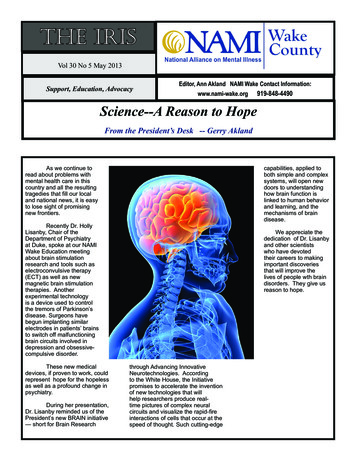
Transcription
The IrisVol 30 No 5 May 2013Support, Education, AdvocacyEditor, Ann Akland NAMI Wake Contact A Reason to HopeFrom the President’s Desk -- Gerry AklandAs we continue toread about problems withmental health care in thiscountry and all the resultingtragedies that fill our localand national news, it is easyto lose sight of promisingnew frontiers.capabilities, applied toboth simple and complexsystems, will open newdoors to understandinghow brain function islinked to human behaviorand learning, and themechanisms of braindisease.Recently Dr. HollyLisanby, Chair of theDepartment of Psychiatryat Duke, spoke at our NAMIWake Education meetingabout brain stimulationresearch and tools such aselectroconvulsive therapy(ECT) as well as newmagnetic brain stimulationtherapies. Anotherexperimental technologyis a device used to controlthe tremors of Parkinson’sdisease. Surgeons havebegun implanting similarelectrodes in patients’ brainsto switch off malfunctioningbrain circuits involved indepression and obsessivecompulsive disorder.These new medicaldevices, if proven to work, couldrepresent hope for the hopelessas well as a profound change inpsychiatry.During her presentation,Dr. Lisanby reminded us of thePresident’s new BRAIN initiative— short for Brain ResearchWe appreciate thededication of Dr. Lisanbyand other scientistswho have devotedtheir careers to makingimportant discoveriesthat will improve thelives of people wth braindisorders. They give usreason to hope.through Advancing InnovativeNeurotechnologies. Accordingto the White House, the Initiativepromises to accelerate the inventionof new technologies that willhelp researchers produce realtime pictures of complex neuralcircuits and visualize the rapid-fireinteractions of cells that occur at thespeed of thought. Such cutting-edge
NAMI Wake CountyThe IrisPage 2Psychiatric Hospitalization in NC in 2013By Ann AklandThrough our involvement as volunteers withNAMI Wake County, my husband Gerry and I encountermany people who are unhappy and confused about thecare they or their relatives receive during an inpatientpsychiatric hospitalization. For that reason, I thoughtit might be helpful to provide my perspective on whatyou might expect in the current mental health careenvironment.In the good ole days, your psychiatrist wouldprobably have been able to find a psychiatric hospitalbed for you by phoning UNC, Holly Hill, Duke or anotherhospital. Unfortunately, those days are gone.So, how do you get voluntary inpatient help?The first thing to realize is that there is a shortage ofhospital beds which limits admissions to those who haveserious issues that can’t be handled on an outpatientbasis. If you do need inpatient help, you should realizethat regardless of your preference, you may be sentsomewhere else depending on bed availability. It is alsolikely that you will have a long wait, sometimes severaldays or longer. Another common occurrence if you arefound to be a danger to yourself or others, i.e. underinvoluntary commitment orders, and if you are transferredto another hospital, is that you will likely be handcuffedand transported by law enforcement.The usual choices for inpatient psychiatricevaluation for Wake County residents are these: If youare interested in admission to Holly Hill Hospital, yourpsychiatrist can phone Holly Hill Access to let them knowyou are coming and to give them some background,but you will be triaged with all the other patients whoare seeking admission. If you are interested in going toUNC’s Neurosciences Hospital, you will be advised togo to the Emergency Department (ED) where you willbe triaged. If they determine you meet the criteria foradmission you will be held in a special part of the EDreserved for psychiatric patients until a bed is availableeither at UNC or another psychiatric unit elsewhere inNC. Similar scenarios occur throughout the hospitalsystem. If you go to a hospital ED in Wake County, e.g.Rex or WakeMed or Duke Raleigh--hospitals that do nothave a psychiatric unit--they will determine whether youneed to be transferred to a psychiatric hospital/unit and,if so, will find a bed. Another option in Wake County isthe Wakebrook Crisis and Assessment Center, operatedby UNC Healthcare, which focuses just on behavioralhealthcare. Wakebrook is a good choice if you donot have health insurance because Wake County hascontracts for behavioral health beds and Wakebrook staffcan authorize admission to those beds. Wakebrook isalso the drop off point for involuntary commitments forWake County law enforcement. And anyone can walkin for a behavioral health assessment in a crisis. Justkeep in mind that if you need admission to a psychiatricunit, your status will be an “involuntary commitment”even if you are willing to go. That allows transport by lawenforcement.In this area, residents are sometimes sent tothe state-run, Central Regional Hospital in Butner, NC.Admissions to this hospital are generally reserved forpatients who need longer term care (from a couple ofweeks to a few months) than can be provided at HollyHill or a regular community hospital psychiatric unit orfor those patients who have a history of violence or otherissues that cannot be accommodated in a communityhospital.While long term residential care at our statehospitals was the norm for people with very serious andchronic mental illness just 10 years ago, it is virtuallynonexistent today. There are very few private residentialcare facilities for adults, and they are extremelyexpensive, e.g. Cooper Riis, http://www.cooperriis.org/in the western part of the state. There are also limitedoptions for children who need psychiatric residentialtreatment. One facility, Strategic Behavioral Healthcarerecently opened in Garner.Because hospital stays are expensive, outpatientcare is the preference of insurance companies andmanagers of our state mental health system. It is prettytypical for patients to go into a psychiatric hospital/unitand stay only a few days until the immediate crisis isover. A week to two weeks is considered a long stay.Although most hospitals have therapy groups, mostof the emphasis is on medication adjustments. Moststays aren’t long enough for the drugs to reach their fulleffectiveness or for patients to adjust to the side effects.That makes it essential that you ensure your outpatientpsychiatrist and therapist are aware of changes in yourmedication. Getting the right combination of medicationsis generally a lengthy trial and error process working withyour psychiatrist.My advice is to find a good outpatient psychiatristand therapist who have good credentials, stay up-to-datein their specialities, are easy to relate to, and are availablein a crisis. Of course, even with good outpatient care, youmay still need to be confined to an inpatient hospital if youare a danger to yourself or others. But my experiencetells me that there are many more opportunities for acorrect diagnosis, medication management and usefultherapy working with your outpatient providers who canget to know you. A few 10-minute encounters with apsychiatrist/resident in an inpatient unit generally don’tresult in the insight and “aha” moments that many familymembers and patients expect. Just remember, you aregenerally being hospitalized for safety reasons, notbecause there are experts in inpatient units that are moreknowledgeable than your own outpatient providers. Fewmiracles occur in an inpatient setting.
NAMI Wake CountyThe IrisPage 3Schizophrenic. Killer. My Cousin.By Mac McClellandMother Jones, May/June t’s insanity to kill your father with a kitchen knife. It’salso insanity to close hospitals, fire therapists and leavefamilies to face mental illness on their own.“’None of us are suggesting that we need to go backto 1930, when I as a psychiatrist could say, ‘I don’t likethe sound of your voice, so I’m going to keep you in myfacility that I also happen to own for three weeks.’ Youhave to have a system of checks and balances.’“But the pendulum has swung far past patients’ rightsand well into the territory of wild neglect. The dismantlingof the mental-health system has left those willing toundergo treatment with no options, and rendered thelaws to protect against dangerous scenarios ineffective.‘Danger to self or others is defined too limitedly,’ (Dr. E.Fuller) Torrey says. ‘(Y)ou either have to be trying to killyour psychiatrist or trying to kill yourself in front of yourpsychiatrist.’ Some states have less-strict provisions, buteven there, no open beds plus the expense of keepingsomeone in the beds equals admission standards that aretoo high and discharge standards that are too low.“Regardless of what you think about commitment rules,the bottom line is you have to have facilities. If there hadbeen a facility—not ‘a psych ward in a general hospitalwhich is set up to see people with eating disorders anddepression,’ Torrey says, but a clinic staffed with theappropriate kinds of professionals and with an open bedand antipsychotics that have proven to be extremelyeffective if properly administered— if my Uncle Markcould have taken Houston someplace like that—maybecrimes like Houston’s could be not just predictable, butpreventable.”In ‘no-man’s land,’the mentally ill pile up in NC jailsby By Craig Jarvis — cjarvis@newsobserver.comAll his mother wanted to do was get help for her son. If he resumedtaking his medications for bipolar disorder, he could get back on track.But the police, who she hoped would take James Franklin Taylor Jr.to a crisis treatment center, instead booked him into the Wake Countyjail on assault charges. He has now been there for more than threemonths, refusing to take his medications or to even talk to anyone ashe deteriorates into incoherence with no clear path out of jail.That’s not the way it’s supposed to work, but Taylor’s situation is notunique. North Carolina’s county jails hold thousands of mentally illinmates, some of them waiting for weeks or months to be evaluated ortreated.This is not just a problem in North Carolina. Over the past severaldecades across the country, patients who were phased out of largeinstitutions so they could be treated in their communities found therewasn’t enough help. Without treatment, many ran afoul of the law andthen tumbled into a nightmare of compounding problems.Nationally, studies estimate between 15 and 20 percent of jail andprison inmates have a serious mental illness.In North Carolina, that translates to roughly 5,500 in prison and anestimated 3,400 people languishing in jails that were built to holdthose charged with crimes for only a short time, all of them withschizophrenia, bipolar disorder and other illnesses. To compare, thestate has 850 beds in its mental hospitals.“This has become a very, very common occurrence,” said AdamAdams, a psychotherapist who evaluates jail inmates in Wake County.“They sit in jail for months, sometimes on a very minor offense. Jailhas become the largest mental institution in the state.”For the past two decades, police across the country have beenlearning special techniques in handling the mentally disturbed througha concept called crisis intervention team training. Raleigh police haveembraced the concept and have trained about 150 officers. That’s 19percent of the department; mental health advocates would like to seeit closer to 25 percent.Gerry Akland, president of the Wake County chapter of the NationalAlliance on Mental Illness, has trained police in that method. He saidit’s difficult to second-guess how an officer handles a confrontation likethat, and officers have broad discretion. But, he said, training needsto improve to give them a better sense of situations such as Taylor’s,where they have to decide whether to ignore a crime in order to divertsomeone from jail. “So far, the training has not gone into that kindof depth,” Akland said. “Those are tough things for an officer to dealwith.”Read the entire article at the following 0/in-no-mans-landthe-mentally-ill.html
NAMI Wake CountyThe IrisPage 4A Visit to Dix HillOn Saturday, May 4th, my husband, David and I walked in 2013 NAMIWalk on the campus of Dorothea Dix Hospital. NAMI is a grassrootsadvocacy organization founded by family members of persons withschizophrenia in the 1970s. These family members came togetherto advocate for better care of their relatives, and for mental healthprofessionals to stop blaming families for causing schizophrenia. Today,NAMI is the one of the largest mental health advocacy groups in the US,with national and state offices, and local groups that vary in the intensityof their grassroots work. Their focus is much broader than schizophreniathese days.I walked with a team from the UNC School of Social Work, and raninto lots of friends, as I’ve been in the mental health field in NC for thepast twenty years. I saw kindred spirits from NAMI Wake, Gerry andAnn Akland, and Louise Jordan, and my friends from NAMI Orange,Lisa Hamill, and Barbara and Gove Elder. Barbara and Gove are alsoactive with Faith Connections, and are working with faith communitiesto be more inclusive of persons with mental illness. I walked with formerclients, and with Club Nova members.The Dorothea Dix Hospital, originally called Dix Hill, was created throughthe advocacy work of one woman: Dorothea Dix. Starting in the 1840s,she crusaded across the US for moral treatment of the insane, creatingreports on how they were inhumanely housed in prisons and poorhouses,and was successful in getting state legislatures to make land grants tocreate state hospitals. In the early days, the state hospitals in NC werefull communities -- with working farms growing food to feed the patients,and patients working in the facilities on the grounds.wayside in NC. The headline in the Raleigh News and Observer thismorning is about the increasing number of the mentally ill in jails. Theyland there for minor offenses, don’t get proper treatment, and get worse,not better.In No Man’s Land: The Mentally IllBefore we left the grounds, David and I knew that a visit to Dix Hillwouldn’t be complete without a stop at the Dix Cemetery. Starting in1859, patients who died were buried on a lovely hillside. If they had nofamily, they got a plaque. There were long rows of these small plaques.Some were visible, some were not. Were they buried beneath the grass,or had they been removed? We saw dates that spanned a hundred years.If there was someone who loved you, you might have a monument -- wesaw two honoring mothers.Dave and I enjoyed our day -- we had fun with friends, raised money fora good cause, and we visited ghosts who constantly remind me of whyI do what I do.Ms. Dix, we still have a long way to go. Whatever happens with thisbeautiful land in Raleigh, I hope we won’t forget your vision of humanecare for persons with mental illness, and that your spirit will stay aroundto sustain us.The history of Dorothea Dix HospitalAt the end of her life, Dorothea Dix was dissatisfied with her progresstoward improving the care of the mentally ill. There was a significanthistorical event that may have gotten in the way: the Civil War. Duringthose years, she shifted her care to nursing the war wounded.The Dix campus is currently in the news -- it’s a beautiful piece of landwith rolling hills, expanses of green, and lovely trees. The hospital closedlast year as part of the state plan to shift care from the state hospitalsto local communities. The empty forensic unit building looks grim withits fences topped by barbed wire, but the cottages with stone fronts arelovely. And many state workers in the NC Department of Health andHuman Services still work in buildings on the grounds.What will become of Dix Hill? The city of Raleigh, and a group ofprominent citizens called the Dix Visionaries, foresee a city park alongthe lines of NYC’s Central Park. In her last days in office, Gov. Perduesigned a contract with the City of Raleigh to lease the land for a park.But, the Republican legislature is challenging the deal.Dix Legacy ParkWhatever the outcome for the land, the vision that Dorothea Dix hadfor humane care of the mentally ill seems to have been thrown to theby Bebe SmithBebe Smith
NAMI Wake CountyThe IrisPage 5Friends, family say Raleigh man who died after Tasing incident battledPTSD after Gulf WarBy Thomasi McDonald — tmcdonald@newsobserver.comRALEIGH — Thomas “Tommy” Sadler emerged in the public spotlighton April 10 as a naked man yelling obscenities in a church parking lotjust before he died after a Raleigh police officer used a Taser stun gunto try to subdue him.“He would be back over there in his mind,” Lynn Sadler said. “Hewould relive those things.” The couple separated and divorced in2007. Tommy Sadler moved to North Carolina, and Lynn Sadlermoved into the new home they had built.Stan Williams, Sadler’s morning coffee drinking buddy, recognizes thatpart of his friend. “He had anger issues,” Williams said of Sadler. “Itwas like a temper tantrum lived under his skin, ready to explode at anymoment, like Tourette’s syndrome. It just comes.”“I loved him, but we weren’t able to have a healthy relationshipanymore,” she said. “Even my best friend loved him. She bawled hereyes out when she heard about the divorce. He told funny stories andalways had lots of interesting things to talk about. He was witty andhad a very creative mind.”But Williams also remembers a guy who loved his parents anddaydreamed of owning a silver, 1969 Plymouth GTX with a burgundyinterior. Williams said casual conversations at their favorite coffeeshop on Hillsborough Street would often turn serious when Sadlerasked him how to better communicate with his live-in girlfriend or howto tell his son he loved him. “He was just a big, fat country boy wholoved his Mommy and Daddy,” said Williams, 50, of Raleigh. “He waslike a little kid in a 45 year old’s body.”During his encounter with police, Sadler collapsed in the middle ofthe street, about 50 yards from the home he rented on Mial Street inthe Five Points neighborhood, and was pronounced dead. The StateBureau of Investigation is reviewing the incident. The results of anautopsy to determine how Sadler died have not been released.Thomas Jeffrey Sadler grew up in the small town of Powhatan, Va.,west of Richmond. After high school, he enlisted in the U.S. Marinesand saw combat during the Gulf War, according to his ex-wife, LynnSadler.After his military discharge, Sadler briefly attended two small collegesin Virginia but left school and was invited to try out as a linebackerwith the Cleveland Browns and Green Bay Packers, Lynn Sadler said.She said her former husband’s dreams of a pro football career werequashed after he injured his knee.Instead, he enrolled at George Mason University in Northern Virginiaand majored in sociology. Lynn Sadler was studying nursing atShenandoah University. A cousin of hers introduced them. “We fell inlove immediately and became the best of friends,” she said.The Sadlers graduated in the spring of 1998 and married later thatyear. Their only child, Thomas James “TJ” Sadler, is now 12. Thecouple purchased a townhome in a new subdivision in Bristow, Va.,southwest of Washington, D.C. Tommy Sadler worked in portfoliomanagement for a private company, while his wife worked as a nurse.“He was making bank,” Lynn Sadler said. “It was well over 100,000.”Lynn Sadler said she and her former husband were building a newhome when things started to go downhill. “He changed,” she said.“He was irritable, unsettled, and he just couldn’t seem to find his nicheanymore and instead of laughing we were having more arguments.”Tommy Sadler was also having nightmares about the Gulf War.Lynn Sadler said her former husband was diagnosed with posttraumatic stress syndrome while living in North Carolina. Sheremain
have a psychiatric unit--they will determine whether you need to be transferred to a psychiatric hospital/unit and, if so, will find a bed. Another option in Wake County is the Wakebrook Crisis and Assessment Center, operated by UNC Healthcare, which focuses just on behavioral healthca











